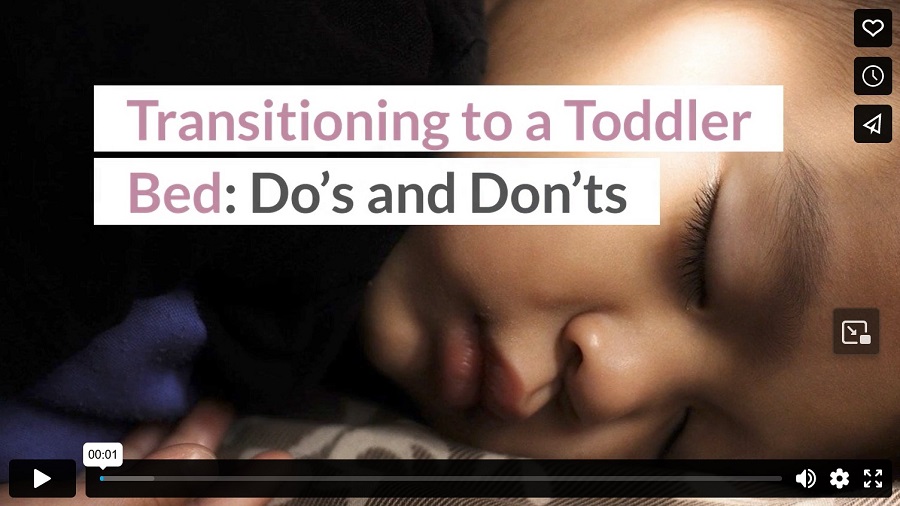Here’s a little haiku to start things off right:
The pitter-patter
Of feet and hands exploring.
Thump! Newfound freedom.
Yep, we’re talking about those first couple of times crawling (or falling) out of the crib.
Few things are more exciting (for toddlers) and terrifying (for parents) than the moment a kid realizes that his crib is not a permanent form of confinement. Suddenly drawers are being emptied, books are being opened and torn, and the door is getting more use than ever.
Unlike some other milestones, like starting solid foods or walking, transitioning to a toddler bed is dependent completely on the kid. Staging the first jailbreak could happen as early as 15 months, or it could not happen at all. Some children despise their crib, others have the spirit of adventure as a motivating factor to get out, and there are even children that want to stay in a crib forever. It all just depends on the kid.
Sooner or later, though, every child will need to transition from a crib to a big-kid bed – whether it be a smaller toddler bed or a twin. You may want to start the transition for a few reasons:
- Your child is getting too big for the crib
- You need the crib for an upcoming baby
- Your child keeps crawling out/safety is an issue
- You want to prevent significant attachment to the crib
Whatever your reason for transitioning, there are a few options for big-kid beds that you can try to ease the transition:
a. Floor bed: This style of big-kid bed is fairly trendy right now in Montessori-type parent groups. A floor bed is a mattress that sits directly on the floor or on a very short stand with no side rails, and the idea is that being close to the floor facilitates independence from a young age. Proponents of the floor bed suggest that even young babies can use floor beds successfully, which cuts down on transition time later in childhood.
b. Toddler bed: A toddler bed usually is a frame that sits fairly close to the ground. It uses a crib mattress, and there are typically bumpers or side rails to keep young children from rolling out of bed. Toddler beds can be simple, wood-slat beds, or they can be plastic character beds in a variety of shapes and colors.
c. Twin bed (or larger): It is entirely possible to skip the toddler bed stage and transition right into a twin bed or larger. It may seem like a big jump to go from baby-size to grown-up-size, but as long as you put sufficient safety measures in place (side rails, bumpers, step stool, etc.), there shouldn’t be a problem.
The type of big-kid bed you choose will depend entirely on your circumstances and your child’s maturity and temperament. That said, even if your kid shows all the signs of transition readiness, they could experience some anxiety actually making the shift. Here are some sleep help do’s and don’ts to support a smooth transition:
DO ACCEPT HELP… from your toddler, that is. Most of the time, toddlers want to be big helpers, and setting up the toddler bed is no exception. The more you allow your toddler to be an active participant in the transition process, the better things will go for you both. That might mean that you let your toddler help you pick out and assemble the new bed. You might also take your toddler on a special trip to the store to pick out new bedding and a big-kid stuffed animal.
DON’T TALK BAD ABOUT THE CRIB… instead, focus on all of the positives of the new bed. Talk about how easy it is to get into and how it’s great for big kids to use. If you can, you might try to leave the crib up in the same room for a little while, so your child doesn’t feel like a comfort item was taken away. You might find your child sleeping in the crib for a few nights, but with the cool, new bed nearby, you’ll probably see a seamless shift pretty quickly.
DO USE THE BED DURING THE DAY. If your toddler is nervous around the new bed, you can make a concerted effort throughout the day to spend time on or near the new bed. Do all of your bedtime routine things on the new bed, even if your toddler continues to sleep in the crib for a few additional days. Read lots of books, have tickle fights, sing songs, and cuddle as much as possible in the new bed as a way to create positive associations with sleeping there.
DON’T GIVE UP. Be patient! It seems like that is always our advice, but that’s just because it’s true. Some kids are ready from day one, and other kids require a little bit of adjustment. You may even find yourself abandoning the new bed for a month or two and trying again at a later date. There isn’t anything wrong with reading your child’s cues and adjusting for their needs. Eventually, you can train your child to sleep alone in a big-kid bed, even if it takes a little while.
Every kid experiences the big-kid bed transition a little differently, so if you feel like you’re reinventing the wheel, you’re not alone. Remember, you may walk in to find a very pleased toddler covered in shirts and onesies, or you might find yourself listening to your toddler wail by the door until he falls asleep on the floor – both are normal, natural responses. If you find that your patience is running thin, contact one of our toddler sleep consultants today for additional tips and tricks to make the transition as successful as possible.
Video



